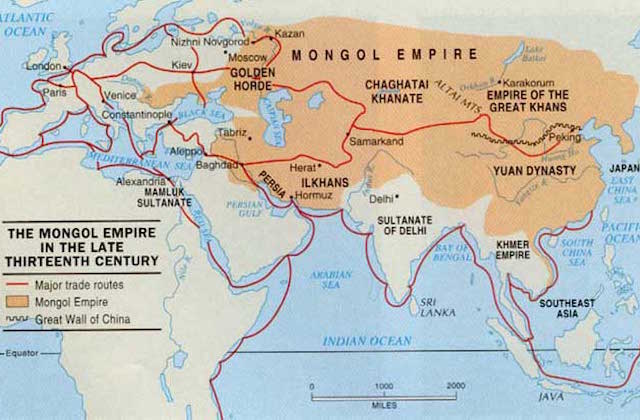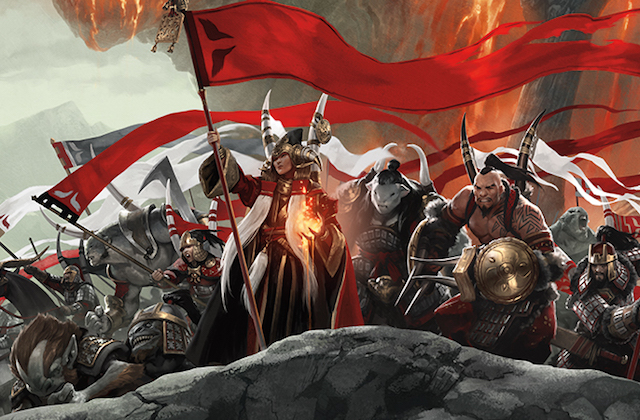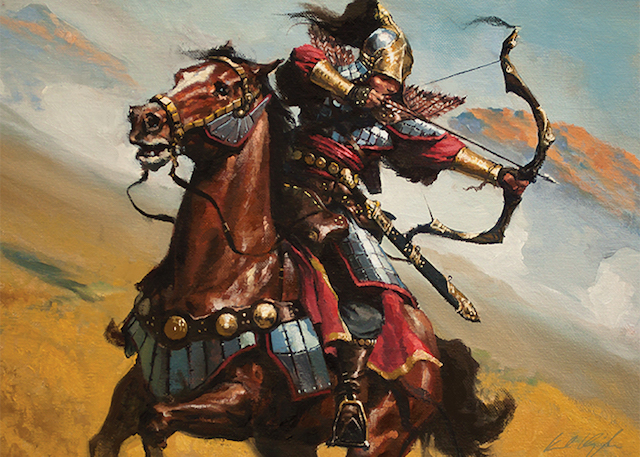By Curtis Wiemann
The year is 1279 CE. After seventy years of uninterrupted expansion, the Mongol Empire has no rival worth the name. More than a fifth of the world’s population answers to the Golden Clan of Chinggis (Genghis) Khan. Now, as branches of his family rule vast empires across Europe and Asia, the Mongol Empire falls into civil war, dividing the inheritance of the World-Conqueror between rival branches of the imperial family. It is a world torn by battle, trampled by clashing hordes, and ruled … by khans.
Sound familiar?
Although without the ragesingers of the Mardu horde, the vast behemoths of Abzan caravans, and the sun-bleached bones of dragons, our own world’s history resembles the plane of Sarkhan’s birth. The cultures and armies of Tarkir inspired this column—A Planeswalker’s Guide To Earth—as a way to explore our own world through the Multiverse of Magic. In the most recent set, and in many of the planes of Magic’s universe, we can see reflections of our world’s past, which is written in flame and struggle every bit as much as the fate of Tarkir.
“What army in the whole world can match the Mongol army?”
In the year 1206 CE, a Mongol chieftain named Temujin took up the title and mantle of Chinggis (often spelled Genghis) Khan before a vast assembly comprised of his loyal followers. This was no simple coronation. Since his birth, likely in 1162, Temujin had endured violence, hunger, and exile by his father’s tribe amidst the hard landscape of the Mongol steppes. Together with his banished siblings and mother, Temujin joined forces as a sworn vassal of a powerful khan, winning loyal soldiers to his banner and slowly eclipsing his would-be allies. Despite (or, perhaps, as a result of) constant betrayal, Temujin rose to become a charismatic and powerful warlord, uniting disparate tribes beneath one banner where they had seldom seen unity before. After a long and bloody war against his own sworn brother and closest ally Jamugha, Temujin had brought all the “people of felt tents”—the nomads of the North Asian steppes—into one nation. “Now that the world is ready for you, what good would I be as an ally?” asked Jamugha upon his capture, sensing the magnitude of his rival’s accomplishments. “If you want to favor me, then let me die quickly and you’ll be at peace with your heart.” With Jamugha’s execution, Temujin was poised to name himself Chinggis Khan—the supreme, unquestioned ruler of the Mongol people. [1]
Although Chinggis was not the first unifier amongst the tribes of Central Asia—Attila and others had come before—his Empire proved an unstoppable force against its rivals to the south and west. The Mongol armies had, in many senses, a natural advantage over infantry armies levied from agricultural nations such as Persia, China, and Kievan Russia. As a force borne from a lifetime spent in saddleback, every Mongol hunter, herdsperson, and trapper could be counted upon as a trained soldier in times of war. “What army in the whole world can match the Mongol army?” marveled a 13th-century Persian historian. “In time of action, when attacking and assaulting, they are like trained wild beasts out after game, and in days of peace and security they are like sheep, yielding milk, and wool, and many other useful things. In misfortune and adversity they are free from dissension and opposition. It is an army after the fashion of a peasantry… [and] also a peasantry in the guise of an army.” [2]
“In time of action, when attacking and assaulting, they are like trained wild beasts out after game.”
The Mongol armies could coordinate over vast distances to converge on an enemy’s exposed flanks, raid and conquer hostile farmland without relying upon slow and vulnerable supply chains, and isolate foes in rival nations as they would corral a herd of prey. By 1279 CE—the reign of Khubilai Khan, the grandson of Chinggis Khan—the Mongol Empire extended from the Red Sea to Moscow, from the Black Sea to the Pacific Ocean.

Source: http://www.iro.umontreal.ca/~vaucher/Genealogy/Documents/Asia/ChinaOverview.html. Their summary of the Yuan dynasty is brief but accurate!
But the united empire of Chinggis Khan could not last. Even by 1279 (the Empire’s most expansive point, after the conquest of southern China), the royal lineage of Chinggis’ clan was starkly divided between four familial branches, who each ruled diverse kingdoms across the breadth of Europe and Asia. The khans descended from Jochi, Chinggis’ eldest son, ruled the Golden Horde, which encompassed modern Siberia, most of Russia, and part of the Germanic Holy Roman Empire at its height. The branch of Changatai, Chinggis’ second son, ruled Central Asia and part of the heartlands of the Mongol steppes in the White Horde. For a time, the branch of Ogodei, Chinggis’ third son, ruled the empire entire; they were unseated by the branch of Tolui, Chinggis’ youngest son, whose family came to rule the Empire of the Great Khans, the Chinese realm of the Yuan Dynasty, and the semi-independent Persian (Iranian) territory of Ilkhanate. By the end of the 13th century, the Mongol domain of Eurasia was much as the plane of Sarkhan’s birth: torn by war between powerful rivals, each convinced of their right to rule the world.
A Planeswalker’s Guide to Earth will continue next week, where we will go deeper into the history of the Mardu clan and its relation to the Mongol horde!
Curtis Wiemann has been playing Magic and reading history for at least 20 minutes now! He plays Legacy and Limited whenever he can.
[1] Paul Kahn, ed., The Secret History of the Mongols (San Francisco: North Point Press, 1984), 120-121.
[2] Ala Ad Din Ata Malik Juvaini, The History of the World-Conqueror, Volume 1, trans. John Andrew Boyle (Cambridge: Harvard University Press, 1958), 30.



